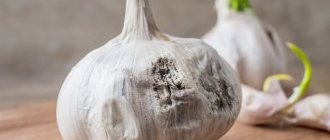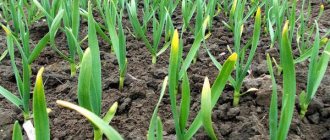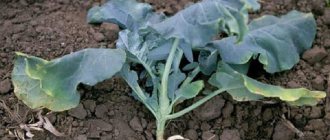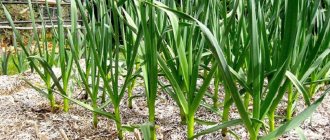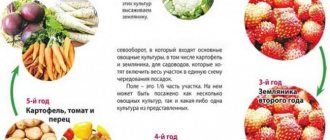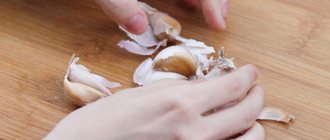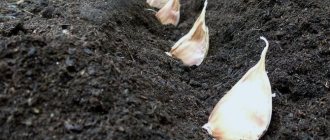Strawberries and garlic together: who are for and against?
Many gardeners specifically grow garlic in the strawberry bed!
Often, some vegetable growers recommend planting garlic with strawberries, while others, those who have tried it, claim that this should not be done. Their argument is simple - there are strawberry bushes, but there are no berries in the joint plantings. Who is right and why is there such disagreement?
The importance of joint plantings
Joint plantings are carried out to achieve different goals:
- Protection . In the era of growing organic farming, more and more vegetable growers and gardeners are trying to do without the use of pesticides, but at the same time not to share their harvest with plant pests and pathogens. The most valuable experience and knowledge accumulated by humanity, in this case, became very popular in relation to strawberries;
- Saving space . In conditions of 6 acres, when you want to plant more of everything, joint planting is very helpful, allowing you to get more products from a unit of area;
- Preventing unilateral soil depletion . It’s no secret that organic matter is not available to many, mineral water is expensive and leads to soil mineralization, but crop rotations allow you to balance on the brink.
Considering all these aspects, the vegetable grower planting strawberries and garlic must be clearly aware of what exactly he wants to achieve.
What plants to plant next to strawberries
After strawberries, wild strawberries and raspberries, soil fertility deteriorates significantly in the fall. Therefore, the next year the land is allowed to rest. How do they do this?
Before wintering, the soil is fertilized with organic and mineral fertilizers, dug up and left until spring; crops that do not require high yields can be planted in this place. What can the soil rest with? List of plants:
See also
Description of the Siberian giant garlic variety, features of cultivation and careRead
- Legumes - peas, beans, beans, lentils. The roots of these plants accumulate nitrogen in the soil; after harvesting, it will be fed with nitrogen minerals.
- Bulbous - onions, garlic. Plants contribute to the accumulation of applied fertilizers and maintain soil fertility; the released phytoncides destroy fungus and repel pests.
- Brassicas - cabbage, radishes, radishes, mustard.
- Greens - parsley, dill, celery, spinach.
- Flowers - daffodils, tulips, peonies and violets.
In the first season, it is recommended to plant garlic and onions, and in the next two years, plant any other vegetable from those suggested above. After strawberries, you need to plant garlic to restore, disinfect and repel pests. But before sowing any crop, the soil must be fertilized with organic fertilizers . How can you feed the beds? To fertilize the soil use:
- cow dung;
- chicken droppings;
- rotted plants and leaves;
- peat.
After 3 seasons, you can continue growing delicious berries in this garden bed.
Why do strawberries need garlic?
So what's the point?
When organizing joint plantings, vegetable growers who vote “For” motivate this with two arguments:
- Garlic, in the process of life activity, releases phytoncides that inhibit pathogenic microorganisms , and strawberries do not suffer from rot and fungi. Opponents of this theory claim that strawberries do not get sick because there is nothing to get sick - there are bushes (healthy and clean) but no berries. The aspect of phytoncidal secretions has not yet been sufficiently studied by science, but this fact does exist. Apparently, strawberries do not really like the “smell” of garlic, and stubbornly do not “knit” the berry.
- Garlic, in the process of life activity, releases phytoncides that inhibit the larvae of the cockchafer, mites, weevils, slugs and other pests of sweet berries, and they leave or die (we haven’t figured it out yet).
Does garlic actually protect strawberries?
Opinions against
Opponents argue that this is not true. If there is a tick, then garlic does not help, slugs do not eat garlic, but eat strawberries, and the cockchafer simply bypasses garlic and eats strawberry roots, although sometimes it also eats garlic.
Research is being carried out everywhere, but, unfortunately , there is no consensus among vegetable and berry growers on this matter . For several decades in a row, the community of German gardeners has closely dealt with the problem of the influence of plants on each other, with their characteristic scrupulousness, but they did not come to a common opinion. Moreover, their results are not just contradictory, but completely deny each other.
Where can you plant strawberries?
You can find ideal neighbors for garden strawberries both in the ridges and in the orchard, and even in the flower garden. This non-conflict crop grows well in various types of soil, which means it will adapt to almost any conditions.
Among vegetable crops, strawberries can be planted next to beans and peas, radishes, carrots and radishes. True, you need to orient tall plants in the garden bed so that they do not shade the strawberry bushes.
Legumes loosen the soil and saturate it with nitrogen useful for strawberries, so you can plant berry bushes either after these crops or together with them.
Planting garden strawberries next to onions or garlic always gives excellent results - the strong smell of these crops repels pests that encroach on the aromatic berries. Planting sage or parsley between rows works the same way, even repelling slugs, which are usually hard to kill. Greens that also go well with strawberries include sorrel, spinach, salads, and borage.
Garlic planted along strawberries reduces the likelihood of late blight affecting the berries and the risk of rotting of the bushes.
If you have seen ridges at your dachas with tulips or irises planted among strawberries, you probably thought that this was done for beauty. However, this is not the main reason for such a controversial neighborhood. In fact, these flowers stimulate abundant fruiting of garden strawberries, and therefore become frequent neighbors for them. In addition to them, strawberries can be planted next to clematis, peonies, ferns, nasturtiums, and delphiniums. And pink-colored strawberry varieties will be an excellent addition to any flower bed.
- All about pink-flowered strawberries: varieties and hybrids with descriptions and photos
Strawberries with pink flowers are not only tasty, but also beautiful! We tell you how these varieties differ and which one to choose.
Marigolds planted between strawberry rows or along the edges of ridges repel onion flies, weevils, nematodes and other pests, and are also a natural defense against fusarium.
You can also plant strawberries in the trunks of trees and berry bushes, for example, sea buckthorn, grapes, pine, and spruce. The main thing is to make sure that the bushes receive enough light and are accessible to pollinating insects. When planting next to conifers, you can organize a real forest corner on your site.
What Science Says
From a scientific point of view, garlic and strawberries are considered highly compatible plants.
But science claims that in order to establish the truth, one must maintain the purity of the experiment.
It all depends on how to plant. Garlic and strawberries can be planted:
- In joint planting (as many novice vegetable growers plant and are left disappointed afterward), plant garlic between the bushes.
- Using crop rotation.
Allelopathy
There is a whole science - allelopathy, which explores and studies the influence of plants on each other, during joint growth and in crop rotation.
According to the crop rotation scheme, garlic is a good predecessor for strawberries.
According to research, plants have:
- direct impact, in close proximity due to secretions of both the root system and the leaf apparatus . Plants emit volatile substances, aromatic, water-soluble, which are washed away by rainwater and the neighbor, due to the fact that there is nowhere to run, consumes them. Such substances can be both growth stimulants and growth inhibitors;
- indirect influence is carried out through the ground . The roots secrete organic compounds, the total mass of which is up to 10%. The chemical nature of these compounds is constantly being studied. They are not the same in composition and properties, and are sometimes toxic. It is this impact that underlies crop rotations and determines the alternation of crops in it.
Planting garlic and strawberries together
It is advisable to plant garlic between strawberry rows . To do this, in the fall, grooves are made between the rows of the berry crop, into which compost or humus is poured, as well as mineral fertilizer - superphosphate and wood (vegetable) ash. In this groove, depressions are made into which cloves of winter garlic are embedded.
Garlic is also planted between strawberry bushes. 2 cloves are buried in each hole. After this, the bed is covered with a layer of organic mulch, for which experienced gardeners recommend using fallen leaves, peat, compost, green manure grasses (without seeds), sawdust or wood shavings.
The biologically active components of garlic will ensure that pests avoid the garden bed.
To protect strawberry and garlic beds from snowless winters and freezing, it is recommended to additionally use a film covering (you can use old film), which is fixed around the perimeter with stones or buried in soil. This technique helps to maximize heat retention in the soil and prevent freezing of the plant root system.
How to plant strawberries and garlic correctly?
Those sources that claim that garlic is an excellent neighbor for strawberries are not entirely right, since it is an excellent predecessor.
Many gardeners dig up garlic and plant strawberries in its place.
But he can be a neighbor, but only if it is planted, for example:
- 5 rows of strawberries;
- Next comes the row spacing;
- 5 rows of garlic.
The best solution would be to alternate narrow beds of strawberries and garlic.
By mid-summer, the garlic is dug up, the bed is cultivated and young strawberry rosettes are rooted on it.
Thus, next year the entire plantation will be under strawberries, and after harvesting, those rows of strawberries that were previously adjacent to garlic are dug up and planted with garlic cloves in the fall.
How to plant garlic in strawberries
The work is carried out in October; winter varieties are used for this purpose.
Important! The head is divided into teeth, disinfected against pests using a salt solution (250 g) per 5 liters of water.
The material is dipped into it for several hours, then dried.
Work algorithm:
- Make a hole whose depth is equal to the height of the tooth multiplied by 4.
You can take a wooden strip and deepen it to the desired size
- The hole is expanded using a garden trowel.
- Sand is placed at the bottom and the hole is filled halfway with fertile soil.
- Plant the clove and cover it with soil.
Holes are made between the bushes. You can also plant garlic between the rows of strawberries at each row-spacing or every other row. The distance between planting material is 25–30 cm.
conclusions
This alternation works great on strawberries and garlic. However, both for one and for another crop it is necessary to prepare beds in advance, using humus and compost.
When using such crop rotation, gray rot from strawberries completely leaves the plantation, and this does not affect the flowering and setting of strawberries.
Using the knowledge of agricultural technology of the crop, the experience of researchers and their observations, the vegetable grower will be able to get a good harvest of both sweet aromatic berries and large, excellent garlic without much hassle.
Why don't I plant garlic and strawberries in the same bed?
Planting several garden crops in one bed is carried out when there is not enough space, to protect against diseases and pests, and for decorative purposes. The choice of neighbors is influenced by compatibility and living conditions - you can plant crops next to each other that have the same needs for lighting, moisture, and soil composition. It is believed that garlic and strawberries planted next to each other help each other, but this placement option also has its opponents. Considering the pros and cons will help you make a choice.
"Friends" of garlic
With the onset of sunny days in spring, many plants need shade from direct sunlight.
For example, beets and strawberries will be ideal neighbors for garlic. Garlic will repel aphids.
The garlic aroma scares the Colorado potato beetle, so you can plant it next to potatoes.
You can plant garlic next to flowers: roses, carnations, gladioli, asters. This will prevent black spotting, powdery mildew, and gray rot. Garlic itself is protected from onion flies by calendula and chicory.
It is good to plant the future garlic crop in adjacent horseradish beds, as they mutually increase the concentration of vitamin C in the leaves.
The best neighbor you can imagine for garlic is the strawberry. Garlic protects strawberries from diseases caused by fungi, as well as from underground pests, and repels slugs and mole crickets. Strawberries, in turn, contribute to the formation of a large head with many cloves.
The antiseptic properties of garlic and carrots can be no worse. The phytoncides released by it protect carrots from carrot flies. The enzymes that carrots secrete into the soil help the neighbor maintain the green color of the above-ground part longer and contribute to the ripening of a larger bulb. In addition, it significantly saves space on the beds and also improves the quality of fruit storage.
Culture compatibility
There are crops that are better to grow nearby. Planting them together has a number of advantages: it increases mutual yield, protects against many diseases, viruses and pests, and saves free space in a small area.
It is worth familiarizing yourself with the recommendations for growing plants together:
- A mixed garden with crops that consume the same substances from the soil that are beneficial for growth is not suitable for growing together. A struggle will arise between them, and each plant will not receive enough of them, will grow more slowly and produce a weak harvest.
- The different needs of crops for watering will lead to the fact that one crop will not receive enough moisture, while another may begin to rot.
- A taller plant will not sit well next to a smaller one. It will create excessive shadow, and the latter will not be able to fully develop due to lack of light.
- Plants that are susceptible to attack by the same pests or prone to the same diseases will, when infected, inevitably infect a neighboring crop.
Opinions of opponents of joint planting of garlic and strawberries
Proponents of mixed growing have opponents who argue in favor of their opinion.
Why aren't garlic and strawberries planted together?
- common pests (tobacco thrips, some types of nematodes, garlic and spider mites, weevils, aphids), which, affecting one crop, will lead to infection of neighboring plants;
- When digging up garlic, there is a high probability of damage to the strawberry root system.
Whether or not to plant strawberries and garlic on the same bed is an individual choice and depends on the growing conditions. It is not possible to plant them together - you can make beds side by side to use garlic phytoncides for their intended purpose.
